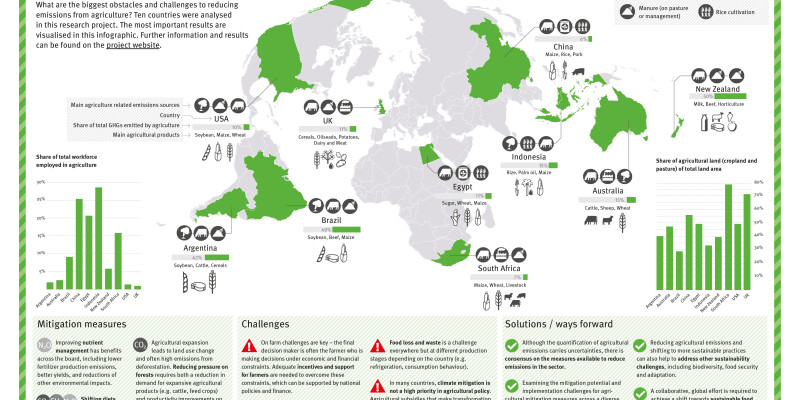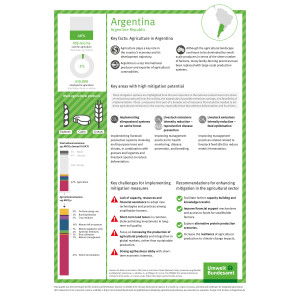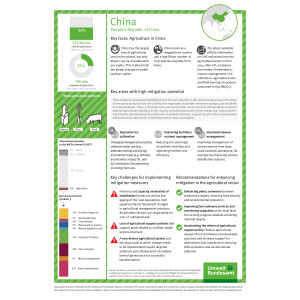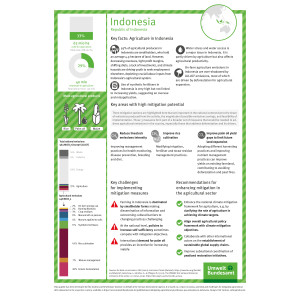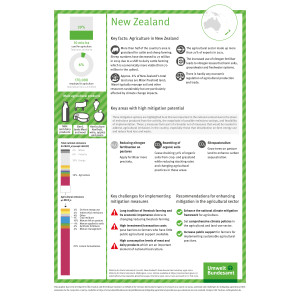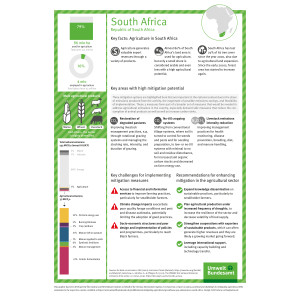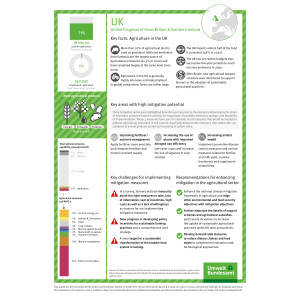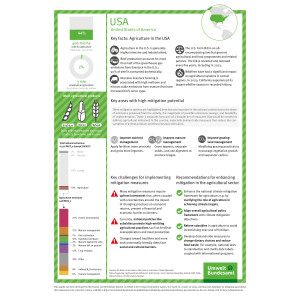Overview: Global agriculture and climate action
Agriculture is responsible for supplying food and it provides a livelihood for many people around the world. It therefore plays a key role in achieving the global Sustainable Development Goals (SDGs). However, global warming and changes in precipitation levels can lead to crop failures and threaten the livelihoods of large numbers of people in rural areas.
At the same time, the agricultural sector is part of the problem: the IPCC Special Report on Climate Change and Land Use estimates that one-fifth to one-third (21–37 percent) of global greenhouse gas emissions can be attributed to our food systems: 9-14 percent are caused by crop production and livestock farming on agricultural holdings, 5-14 percent by land use and 5-10 percent by the food production value chain. Unlike other sectors, agricultural production is associated with greenhouse gas emissions that cannot be decarbonised, i.e. replaced by greenhouse gas-neutral processes. These include methane, nitrous oxide and carbon dioxide (CO2) emissions resulting from agricultural land management, digestive processes in ruminants and the storage of manure.
In addition, the intensification of agriculture and trends towards large-scale monocultures are a key cause of biodiversity loss and increasing pressure on ecosystems and water resources. This is primarily due to the high and continuing increase in the consumption of animal-based foods and products. Without a shift to a predominantly plant-based diet and the implementation of further climate mitigation measures, it will not be possible to achieve the goals of the Paris Agreement. In addition, it is becoming increasingly difficult to keep the environmental impact of the food system within planetary boundaries.
In order to make the agricultural system more sustainable, several goals must be pursued simultaneously:
• preserving ecosystems
• reducing greenhouse gases
• adapting to global warming
• providing safe and healthy food for all
There are many known solutions for reducing greenhouse gas emissions. Nevertheless, ambitious climate action in agriculture on a large scale has not been implemented.
Challenges and solutions for a more sustainable agriculture
The primary task of agriculture is to ensure food security and provide food at socially acceptable prices. However, the existential relevance of the sector also means that calls for ambitious climate action are often avoided. In addition, there is limited technical mitigation potential, as agricultural production is inherently linked to greenhouse gas emissions due to its biological processes. Agriculture is a complex system with a large number of actors and very different conditions, backgrounds and needs in different countries. But even where options for greater climate action in agriculture are clearly evident, they are often not implemented.
Solutions for more sustainable agriculture:
Examples for supply-side climate mitigation measures:
• More extensive farming methods
• Better management of nitrogen fertilisers
• Improved management of farm manure
• Reduction of emissions from livestock farming
• Increased carbon storage in agricultural systems
• Reduction of greenhouse gas emissions from rice cultivation and less burning of crop residues.
Examples for demand-side climate mitigation measures:
• Reduction of food waste and losses
• Change in eating habits
• Reduced deforestation.
There are institutional, political, financial, socio-cultural, technical and biophysical barriers to implementing these options. Appropriate approaches for developing climate-friendly food systems must be context-specific, as both agricultural systems and the obstacles to implementing mitigation approaches vary greatly and are specific to local conditions.
Analysis: Mitigation potential in ten countries across continents
The natural, political, cultural and social conditions vary greatly depending on the region of the world. It therefore makes sense to take a closer look at individual countries on different continents. The potential for ambitious climate action in agriculture was analysed for Egypt, Argentina, Australia, Brazil, China, Great Britain, Indonesia, New Zealand, South Africa and the USA. In addition, selected mitigation measures were examined in depth and quantified, and obstacles and barriers to the implementation of the mitigation options were identified.
Summary of results
The most suitable mitigation options vary from country to country and depend on factors such as local climate, main agricultural products and existing agricultural systems. For each of the 10 individual countries, national conditions and current mitigation plans were examined to identify where additional mitigation potential exists. To this end, a qualitative analysis of the characteristics and circumstances of the agricultural sector in each of the selected countries was conducted, based on existing emission profiles for agricultural activities, socio-economic background, trade and employment data, current national climate policies, the vulnerability of the agricultural sector to the effects of global warming, and trends in food consumption and waste.
Sources of emissions in agriculture vary from country to country, but common patterns emerge, with emissions from livestock farming (enteric fermentation), manure management, manure applied to agricultural land and energy consumption on farms being the most significant contributors to agricultural emissions in all countries, and fermentation often being the largest source. In countries where rice is a staple food and is grown extensively, emissions from rice cultivation account for a large proportion of total agricultural emissions (e.g. China, Indonesia, Egypt). Emissions from crop production mainly come from the use of synthetic fertilisers. In most of the countries analysed, farmers currently over-fertilise their fields, partly due to the low cost of fertilisers as a result of government subsidies, which leads to significant nutrient losses and corresponding environmental pollution and emissions.
In some cases, LULUCF emissions (land use, land use change and forestry) can completely overshadow agricultural emissions. Emissions from land use change are generally driven by deforestation to expand agriculture. In the case of Indonesia, this also includes the drainage and burning of peatlands. Of the ten countries studied, emissions from deforestation are particularly relevant for Indonesia and Brazil, but also for Argentina and the United States.
The relevance and potential of individual measures vary both regionally and nationally. These depend, among other things, on the main agricultural products, the degree of intensification of production systems, climatic conditions and the need to adapt to climate change, cultural and socio-economic conditions, and the nature of agricultural trade. Especially in countries where food security is not guaranteed for the entire population, any mitigation measure must be considered in the context of national development priorities.
Three main factors determine where the greatest mitigation potential lies in a country:
• the main sources of emissions in the country
• the footprint of existing agricultural systems in terms of their emission intensities (tCO2e/tonne of product)
• the sustainability of production systems
Such production systems are often associated with high resource use, which causes emissions in other sectors (e.g. fertiliser production, energy consumption on the farm) or leads to higher indirect emissions through increased fertiliser use and/or feed production for livestock farming, including emissions from deforestation for land use.
Stopping agricultural expansion, which leads to deforestation, particularly in tropical countries (e.g. Brazil and Indonesia), offers the greatest potential for mitigation. However, reducing emissions from enteric fermentation also offers considerable mitigation potential, particularly through demand-side measures to reduce domestic consumption of animal products. Enteric fermentation is a key source of emissions in most countries, including emerging economies that are heavily dependent on animal product exports for their economies. While the reduction potential of certain agroecological practices such as cover crops and improved crop rotation is considered to be rather limited based on the literature, they nevertheless offer numerous additional benefits, for example by promoting adaptation to the effects of climate change. In addition, these are measures that can be implemented on a large scale without significant disadvantages or risks.
Furthermore, land-based mitigation measures that increase carbon stocks on agricultural land are an attractive option for climate action and have a fairly high potential to create additional sinks. These include, for example, the restoration of grasslands and agroforestry/silvopastoralism, which combines woody plants with grazing land and livestock farming. However, there are many risks and uncertainties regarding their effective implementation. Activities to store carbon in biomass should not replace the decarbonisation required in the agricultural sector to achieve climate targets and emission pathways compatible with 1.5 °C.
In addition to reducing greenhouse gases in agricultural production, it is essential to emphasise that a sustainable path to limiting warming to 1.5 °C is not feasible without changes in dietary patterns, mainly in industrialised countries.
Agriculture in the context of international climate negotiations
Agriculture is the only sector for which there is a separate agenda item within the climate negotiations under the United Nations Framework Convention on Climate Change (UNFCCC). Initially, this agenda item was entitled “Issues related to agriculture” and later became the work programmes “Koronivia Joint Work on Agriculture” (2017-2022) and “Sharm el-Sheikh joint work on implementation of climate action on agriculture and food security” (2022-), both scientific and implementation aspects of greenhouse gas reduction and climate change adaptation in agriculture are discussed. The agricultural sector also plays an essential role in the nationally determined contributions (NDCs) of the states under the Paris Agreement. However, only a few countries have quantified sector targets, i.e. concrete target values, for emission reduction in agriculture or land use. The agricultural sector is therefore a sector in which it is necessary and possible to raise the level of ambition in climate action. This should also be reflected in the NDCs, which are to be submitted every five years.
 Click to enlarge
Click to enlarge
